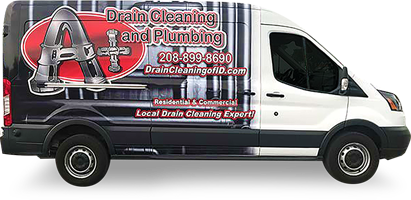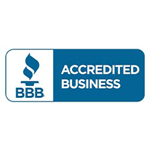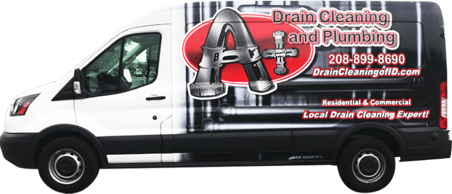SERVICES

Our Comprehensive Range of Plumbing Services in Nampa, ID, and Nearby Areas
From minor repairs to plumbing-related updates. there are many reasons to need some help from a trustworthy and dependable plumber. If this is why you're here, rest assured that A Plus Drain Cleaning & Plumbing of Idaho is the company you can count on for plumbing services in Nampa, ID, and nearby areas.
A Look At What We Provide
Let a plumber in Nampa, ID, or other areas we serve from our team take care of your various needs involving:
As a busy homeowner, your plumbing system is probably the last thing on your mind. You don’t give it much thought, especially when everything seems to be working as it should. But it’s an entirely different story when issues arise. When sewer line problems occur in your home, it’s critical to address them immediately to avoid more costly inconveniences down the road.
A Plus Drain Cleaning & Plumbing of Idaho pins down a few reasons why sewer line repair in Boise, ID should be scheduled right away.
Unpleasant Smells
When there is an issue with your sewer line, it can often cause an unpleasant smell to permeate your home. Not exactly the ideal environment you’d want in the space where you and your family are supposed to feel most comfortable. Trying to mask the odor with air fresheners and candles won’t solve the problem (and let’s face it, no one wants to live in a constant cloud of air fresheners). To get to the root of the issue and make sure it doesn’t keep coming back, you will need assistance from professional sewer repair services.
Mold Development on the Walls
A broken or clogged sewer line can lead to moisture buildup in your home’s walls, potentially resulting in mold and mildew growth. This can cause health and safety concerns, not to mention that it can be challenging (and expensive) to remove. Ignoring such issues or neglecting to replace sewer line pipes that are at the end of their lifespan can put you at risk of a much bigger problem in the long run.
Sewer Backups
One of the biggest reasons to schedule prompt sewer repair is to avoid the nasty mess that comes along with sewer backups. Aside from this being a majorly gross inconvenience that’s expensive to repair, it can become a health hazard if left untreated. And here’s another important point to ponder: sewer backups are not covered under standard home insurance policies. This means that all costs associated with restoration and cleanup will be paid out of your pocket.
Sewer repair is something you don’t want to wait on. Our sewer pipe replacement experts at A Plus Drain Cleaning & Plumbing of Idaho understand that sewer line issues can quickly snowball into something much worse. Hence, we provide timely and reliable solutions that address the problem at its source. Contact us today to schedule an appointment.
Most homeowners worry about costly professional plumbing repairs, and this thought prompts them to try fixing plumbing issues on their own. Seems very economical, but not really. Not only do DIY repairs cost you more in the long run, but they can also seriously affect your plumbing system.
A Plus Drain Cleaning & Plumbing of Idaho explains why plumbing repairs are not the ideal DIY project.
Safety Risks: Your DIY Attempts Can Lead to Disaster
DIY repairs rarely adhere to the same safety standards as professional plumbers. The result? You are putting yourself and your family at risk, whether of being exposed to hazardous material or contracting water-borne illnesses or other nasty diseases that can arise if DIY repairs aren’t done correctly.
A certified plumber in Nampa, ID knows how to safely inspect, repair, and replace plumbing systems without risking further damage or injury to yourself or your home. They are also trained to use various special tools and equipment that make the job easier and more efficient while ensuring the best possible results.
Experience and Expertise: Something You Likely Don’t Have
The most common mistake people make when attempting DIY repairs is underestimating the complexity of the job at hand. Even if you have some knowledge about plumbing systems, you likely don’t have the experience or expertise to do a complex repair properly.
Professional plumbers, however, are experts in their field and know precisely how to assess and fix plumbing issues with minimal disruption to your home or lifestyle.
Inadequate Work: You May Not Fix the Problem
Best-case scenario, your DIY repairs may not last long. Worst-case scenario, you may exacerbate the issue. The simple truth is this: without the proper skills and knowledge required to tackle plumbing repairs, you will likely end up with an incomplete job and the need to call for emergency plumbing services.
Leave plumbing repairs in the hands of a professional plumbing company like A Plus Drain Cleaning & Plumbing of Idaho. We have the experience, training, and knowledge necessary to ensure that your plumbing repairs are done safely and correctly. Contact us today for an appointment!
It’s inevitable for homeowners to experience some form of sewer line issue at one point. At A Plus Drain Cleaning & Plumbing of Idaho, we understand that you want to go the repair route so you can avoid having to undergo the tedious process of sewer replacement. That’s why we have compiled a few signs that should help you decide if it’s time to replace your sewer line or if you just need a routine sewer line repair in Nampa, ID.
Clogged Drains
Clogged drains result from the accumulation of organic material and other particles that cannot get transported through wastewater systems. This clogging can cause the flow of wastewater to slow or stop, which can lead to a backup and overflow. While drain clogs don’t necessarily mean you have to replace your sewer line, chronic clogs are indicative of issues that may necessitate a sewer line replacement.
Sewage Smells
If you notice a foul odor from your drains, a replacement may be in order. The build-up of bacteria often causes this odor due to undisposed organic waste. Moreover, the fact that sewage smells are permeating your home means that the sewer line itself is compromised and needs immediate repairs or replacement–depending on the severity of the damage.
Soggy Patches in your Yard
A soggy patch in your yard could indicate a blockage within the sewer line itself due to clogging. This blockage often occurs during heavy rains, snowmelt, or increased watering schedules.
If this is the case, contact a sewer repair services company to assess the damage on-site and determine the best course of action before further deterioration. It is important to conduct this check on a routine basis.
Sewer Backups and Leaks
Sewer backups are a legitimate sign of an impending plumbing emergency. Your sewer lines need to be inspected as it needs immediate repairs and quite possibly a replacement if need be.Leaks from your sewer line can have serious health and sanitary implications. To eliminate this risk, you will need to replace sewer line sections and connections in the system.
For quality sewer pipe replacement and repairs, turn to A Plus Drain Cleaning & Plumbing of Idaho. Contact us today at A Plus Drain Cleaning & Plumbing of Idaho to schedule an appointment!
When faced with plumbing issues in your home, it is best to seek a company that has a solid reputation for rendering top-quality plumbing services. Not all plumbing companies have teams that are highly competent and can deal with all plumbing issues, such as leaking pipes, septic problems, AC repair, and fixations. There are various qualities and aspects to look for in plumbing companies.
To get the most qualified plumber in Boise, ID, to handle your plumbing issues, here is what to look for.
Level of Experience
When hiring a plumbing company, it is wise to find out how long they have been offering plumbing services. Plumbing companies that are new in the field are most likely to dispatch inexperienced or trainee plumbers. A company with great experience is composed of experienced and professional plumbers who are capable of handling complex issues.
Insurance Coverage
Any company offering plumbing services should have proof of insurance. This means you won’t be held responsible in the unlikely event of mishaps during the repair service. You should always confirm at the beginning of the contract if the company is insured.
Licensing and Certification
Any company doing plumbing work in your home should be licensed by the state. The company should be certified and accredited. This ensures that the company’s team members are amply-trained and have the needed knowledge for the job. Double-checking for this is not an offensive act but simply due diligence. It helps you be sure that the plumber is qualified to sort out your plumbing repairs and other issues.
Good Reputation and Reviews
A good company should have a respectable reputation and positive reviews from previous customers. A good rating helps you know which company to run to in case of emergency plumbing issues. You can also see a company’s level of commitment by how they respond to negative reviews.
Good plumbing companies are always competing to get ahead of the competition. Whether it is a slab leak repair or toilet repair, you should treat any plumbing work with priority and ensure the professional working at your premises is well-qualified and experienced. A Plus Drain Cleaning & Plumbing of Idaho is a renowned company offering you the best plumbing works in your area. Contact us today to schedule an appointment!
A tree-lined yard looks beautiful on the surface, but below-ground, those same trees could be dismantling your sewer line. Trees view your pipes as an excellent source of water and nutrients, so they can cause serious damage to your sewer line over time. A Plus Drain Cleaning & Plumbing of Idaho has provided sewer repair services for countless tree-damaged pipes over the years.
Here’s what you can expect if a tree has decided to spread into your pipes:
Do You Need Sewer Pipe Line Repair?
You may not notice signs of tree damage when the roots are still small, but as they expand into your plumbing, the damage will become more obvious. Pay close attention to these red flags that may require sewer line repair in Nampa, ID:
- Slow draining
- Gurgling drains
- Sinkholes in yard
- Blocked pipes
- Rotting egg smell
If any of these signs sound familiar, you may need sewer line replacement or repairs. Call a plumber in Nampa, ID as soon as possible to schedule an inspection.
Prevention Is Key
You can prevent the need for future sewer repair by carefully planning your landscaping. Before you plant a tree, determine where your underground utilities are located. The local department of public works should be able to provide you with that information. Your new tree should be planted as far from your sewer line and utilities as possible.
It’s also beneficial to choose tree species that have shallow root systems, as they are less likely to root deeply into the ground where your pipes are located. If the damage becomes too extensive, sewer pipe replacement may be necessary.
Sewer Repair Services for Tree Roots
If tree roots are wreaking havoc on your home’s plumbing, the team at A Plus Drain Cleaning & Plumbing of Idaho can help. Our plumbers will inspect your sewer line from top to bottom using a high-resolution camera. Our findings will help us pinpoint the exact location of the damage as well as how severe it is. Once we’ve assessed the situation, we’ll get to work on restoring your sewer line, whether that means repairing a cracked pipe or sewer line replacement.
Need to repair or replace sewer line? Look no further than A Plus Drain Cleaning & Plumbing of Idaho. Our team offers prompt and professional services that are priced reasonably. Call us or fill out the form for an appointment.
Schedule Service
Our Services
Why Choose A Plus Drain Cleaning & Plumbing of Idaho
We're local and familiar with the plumbing systems common in the area. You'll also receive honest answers to your questions and solutions that address your needs in the most cost- effective manner possible. Furthermore, we only offer the drain and sewer services you need when you need them. There's no pressure to go beyond what's right for your situation.
Our plumbing company delivers the level of service our name implies with:
Fair, honest pricing
Careful attention to detail
Punctual service
On-call emergency service





Call Our Local Plumbing Pros Today
End your search for a dependable local plumbing service provider with A Plus Drain Cleaning & Plumbing of Idaho. We're local and ready to address both routine and urgent issues in a way that won't be a major budget stretch for you. Contact us today to benefit from our affordable and personalized drain and sewer solutions.

